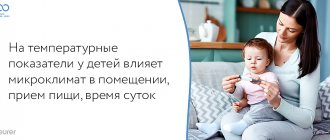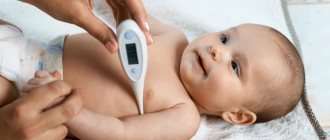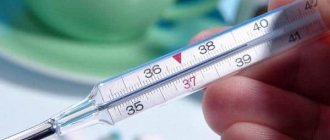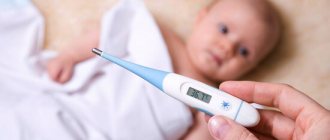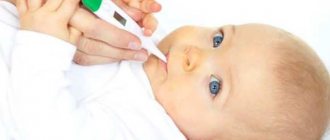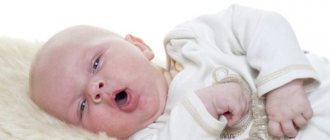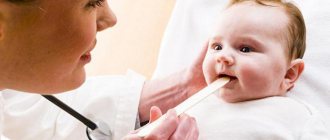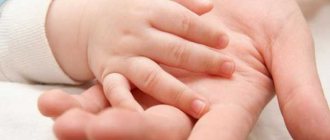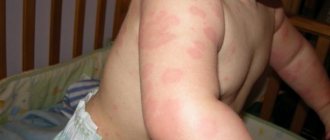Babies are born with an immature thermoregulation system. This means that they cannot control it through rapid breathing or excessive sweating, as we adults do. This is especially true for premature babies. Newborns easily overheat in a stuffy room and overly warm clothes, and they also easily freeze if the air baths are too cool. Under these conditions, mothers are interested in how to measure their baby’s temperature and interpret it. Many questions arise: how can a small child do this carefully? When is elevated temperature a sign of infection, and when is it the result of overheating? This is what we will talk about.
Where can you take your temperature?
— The traditional way is to measure in the armpit. It is actively used in older children, to whom it is already possible to explain why the procedure is being performed, as well as for those who do not yet roll over or sit up, for example, a month-old baby.
— A thermometer is placed in the butt (rectally or in the rectum) for babies using an electronic thermometer. To do this, its tip must first be moistened in Vaseline, and then be disinfected.
During the procedure, the baby is placed on his side and his knees are lightly pressed against his tummy. The thermometer is inserted no further than 1.5–2 cm. The rectal mucosa is very vulnerable, so manipulation must be carried out carefully.
— You can place the device in your mouth. It is important that the child does not try to gnaw or chew it. To do this, it is better to offer the baby a thermometer-pacifier.
— You can also measure the temperature in the ear. This can only be done using an ear thermometer. Other devices are not suitable for this. To place the nose of the thermometer in your ear, you need to slightly pull the earlobe back and slightly up.
We recommend our news
80 Oryol children are waiting for a new kindergarten in Oryol on Kuznetsova
The procedure for accepting applications for registration in kindergarten No. 97 (Kuznetsova St., 5) has been launched.
It was built as part of the implementation of the national project “Demography”. It is ready to accept 80 children aged... 09/21/2021 11:48 Social news
Oryol priests distribute food to needy families
The social service of the Liven diocese delivers food packages, clothes, and hygiene products throughout the Oryol outback for large and low-income families.
One such set weighs about 40 ... 09.19.2021 10:00 Social news
Choosing a thermometer
The assortment of pharmacies is rich in such devices. Some of them are more accurate, others are easier to use. It is easiest to measure the temperature of a sleeping child, because for the correct result it is important that the measuring device is in close contact with the skin for some time.
Mercury thermometer
It is considered the most accurate, as it has the smallest measurement error - only 0.1 degrees. How to measure the temperature of an infant with a mercury thermometer? Take the baby in your arms, carefully place the thermometer nose in the armpit and cover the baby with your hand. You need to hold it for at least 5 minutes, preferably 7–10. To ensure that the baby lies quietly at this time, you can give him the breast if he is breastfed.
This method also has its disadvantages:
— Mercury thermometers break easily, and this is difficult to prevent if the baby has already grown up and is fidgeting in his hands. Mercury vapor is poisonous, especially to children and pets.
— Due to its fragility, the thermometer cannot be inserted into the butt or mouth. In this case, there is a high probability of injuring the child with glass fragments.
Electronic thermometer
The most common and safest option. Mothers love it because it does not break, it can be used rectally, in the mouth, and under the armpit. For babies they produce models in the form of pacifiers. But they are only suitable for those babies who suck nipples.
How to measure a newborn's temperature with an electronic thermometer? Turn it on by pressing the button and insert it under your mouse. Before using it in the rectum, do not forget to lubricate the spout with Vaseline. If it is convenient for you to change the baby’s temperature in this way, then get a separate thermometer “for the butt.”
One of the disadvantages is the large error in measurements - up to 1 degree. Compared to a mercury device, this is a lot, almost 10 times. Also, during operation, the batteries run out, which also affects the accuracy of the measurement.
Infrared device
It is this that is proposed to be used as an ear thermometer. This is done very quickly, in about 5 seconds, so it can be used even by the most restless children.
A non-contact infrared thermometer works similarly. It is brought to the forehead of a feverish child. Some mothers even manage to use it to measure the temperature of the formula.
Compared to other devices, this one has a relatively high cost, and it is not as accurate as mercury.
Disposable device
It is a test strip that is applied to the skin, under the tongue and gives the result within 1 minute. The strips are not very accurate, but can be useful in a travel first aid kit.
Test for checking an electronic thermometer
If you doubt the accuracy of the thermometer readings, you can carry out the following simple test using two thermometers - mercury and electronic and a glass of water. Take plain warm water and place both thermometers there. After three minutes you can already see how well the electronic thermometer works. If the data from the electronic thermometer is very different, then you have a direct route to the service center. In addition, electronic thermometers have a significant warranty period.
By the way, the temperature test can be carried out not only on water, but also on yourself by measuring the temperature with a mercury and electronic thermometer. You can simply remember the difference in readings and then simply “add” the missing degrees. Typically the difference is about 2 tenths. That is, on mercury 36.6, on electronic - 36.4. On mercury 37.5 - on electronic 37.3.
So, let's summarize.
- Be sure to hold the thermometer correctly (vertical/downward angle, press firmly). Do not move with a thermometer.
- Ignore the squeaking sound; hold the thermometer under your arm for the same amount of time as the mercury thermometer until the temperature finally stops increasing (up to 10 minutes).
- Measure the temperature not under the armpit, but in the mouth - the result will be more accurate.
- It is better to first test the purchased electronic thermometer.
- Do not measure temperature with a wet thermometer.
You can read more about electronic thermometers here.
ALSO READ: Rospotrebnadzor named safe countries for travel
Author: Evgeny Kuznetsov
Norm
After measuring your baby's temperature, compare it with the norm. It is different for each measurement location.
- The normal range when measured in the armpit is from 36.3 to 37.3 ⁰C. — In the rectum it is slightly higher – from 37 to 38 ⁰С. — In the mouth, the norm will be 37–37.2 ⁰С. — In the ear 37.6–38 ⁰С.
A rise in temperature is usually a sign of infection, but not always. Physiologically, it increases after crying, eating, active games, and is also slightly higher in the evening than in the morning. Children may respond with fever to overheating, stress, or endocrinological pathology. If there are no external signs of the disease, the child eats well, is active, sleeps enough and is awake, but at the same time he has a fever and needs observation.
Doctors usually advise not to lower the temperature if it does not exceed 38.5 ⁰C. However, this does not apply to children under 3 months of age, babies with developmental defects of the cardiac, nervous or pulmonary systems, as well as those who have already experienced convulsions due to high fever.
Daria Romashko, pediatrician.
Our body is designed in such a way that when an infectious process appears in it, it begins to independently fight it. Processes occurring in the immune system form antibodies even before you take the necessary medicine. They, in turn, use elevated body temperature to prevent further spread of the infection. However, body temperature must be controlled, otherwise a person’s condition may deteriorate sharply and even lead to death.
But what if a child who is not yet talking is sick? The baby cannot complain about feeling unwell and becomes moody, lethargic and tired. Adults should definitely pay attention to the first symptoms of the disease and measure the child’s body temperature. Ideally, his temperature should be taken daily for the first 6 months of his life. After all, it is during this period that the thermoregulation system is formed, and the child is easily exposed to hypothermia and overheating.
Normal values are considered to be 36.3ºC - 37.3ºC. There is no need to worry if the temperature remains at 37ºC for several days without any obvious symptoms of the disease, because the baby’s immunity has not yet strengthened. If you did give him antipyretic drugs, then do not be alarmed, because for some time his body temperature may drop to 35ºC. You can measure the body temperature of a newborn baby using various types of thermometers.
Types of thermometers
Mercury thermometer
This is the most common method, which allows you to accurately measure body temperature, with an error of about 0.1 degrees. This is done by holding the thermometer in the armpit (5-7 minutes) or in the rectum (up to 5 minutes). In the case of a baby, this type of thermometer may not be entirely convenient - it takes too long for a restless baby and there is a risk of a crack, which can lead to mercury coming into contact with the skin. If damage to the thermometer does occur, do not attempt to collect the mercury yourself; it is better to contact specialists from the Ministry of Emergency Situations. Mercury thermometers are cheap and are sold in almost every pharmacy.
Digital Thermometer
A safer type of thermometer that allows you to measure a baby’s body temperature in 2-3 minutes in several ways with an inaccuracy of up to 1 degree: orally, in the armpit (the most inaccurate indicator) and rectally. The meter itself will signal when the measurement is completed. You will have to change the batteries as needed. In addition, electronic thermometers also come in pacifier form, making the process easier for those whose children take a pacifier. Naturally, this method will be effective for as long as your child uses it.
Infrared thermometer
There are two types of such thermometers - ear and non-contact. It is most convenient to use the ears to measure the temperature of sleeping infants. The process lasts only 5 seconds. Contactless is enough to touch the skin, but it is not particularly accurate. A non-contact thermometer is also used to measure the temperature of baby formula. These thermometers are comparatively more expensive than others.
Disposable thermometer
This thermometer is most convenient to use on the road and take with you everywhere. This is a strip that just needs to be placed under the tongue or simply applied to the body for 1 minute. When using strips, please note that they are not very accurate, but they are suitable for checking the dynamics of temperature changes.
How to measure the temperature of a newborn: methods
There are 3 main ways:
- Axillary. This is a classic option when you place a thermometer under your arm and wait for the maximum reading. Newborns usually do not like this process, and they cry and resist, especially if a mercury thermometer is used - with it, measurements take up to 5 minutes;
- Oral. To measure the temperature, it is enough to insert the tip of the thermometer into the baby’s mouth, supporting it with your hand during the process and trying not to change position to obtain reliable results. Not all children respond normally to this method of measurement;
- Rectal. The thermometer is inserted into the butt, after placing the child on the lap of an adult. It is better for the legs to hang slightly. The method is more preferable due to its speed and convenience for the baby;
- Other methods. There are devices for measuring temperature on the forehead, groin, ear, and also using a non-contact method.
Each option has advantages and disadvantages, the main thing is to measure the temperature correctly and safely.
Value norms and rules
With different measurement methods, temperature norms in newborns up to 1 year of life also differ. Approximate temperature values for the traditional axillary method are 36.6 - 37.2, in the mouth - 36.8 - 37.4, rectally - up to 37.5 - 37.6.
If the child cries, the indicators may be biased. It is important that the baby is calm, so choose the method that suits best and does not cause much anxiety. Remember that measurements are best taken during the day when the baby is awake and not wearing a diaper.
If you are going to take a newborn's temperature through the mouth, make sure that the baby does not spin, spit out the thermometer, or clamp it with his teeth (if he already has them). When taking rectal measurements, it is better to lubricate the tip of the device with oil, Vaseline or baby cream. Involuntary bowel movements are possible, so it is advisable to measure after bowel movements. Keep your baby in one position to avoid damaging the rectum.
Temperature measurement methods
Remember that you should measure your baby’s temperature when he is at rest. If the baby cried or played actively, then it is necessary to wait for a certain period of time. Also note that when measuring while feeding, the thermometer reading will be slightly higher.
In the armpit
If your baby is not yet sitting on his own, then carefully place him on his back. Lift the handle up, carefully place the thermometer under your armpit and then lower it. Wait for the signal to complete the measurement with an electronic thermometer or wait 5 minutes with a mercury thermometer. If the baby can sit, then sit him on your lap with his back to your chest. Place the thermometer under your armpit and remember to lightly hold your baby’s hand the whole time until the end of the procedure.
Normal temperature in the armpit is 36.3ºC-37.3ºC
Rectally
Before starting the procedure, lubricate the end of the thermometer with baby cream. Place the baby on his back, grabbing his ankles and raising his legs. The thermometer must be carefully inserted into the intestine no further than a couple of cm. Wait enough time and remove the device. Particular care will be required when using a mercury thermometer. The baby may jerk, after which the glass may crack. In addition, it is necessary to disinfect the thermometer after each use.
Normal temperature in the rectum is 37.6ºC-38ºC
In the ear
You will need an ear thermometer. With careful movements, pull the earlobe back, lift it and place the end of the thermometer in the ear. Also carefully pull out its end of procedure field. You will have to be extra careful because using this type of thermometer can easily damage a child's fragile ear canal.
Normal temperature in the ear is 36.9ºC-38.5ºC
Oral
The only way to accurately determine temperature using the oral method is an electronic pacifier thermometer. Remember to disinfect it after each use. Many people use a regular thermometer, holding it in the child’s mouth at the required distance. This method of measuring temperature increases the risk of errors in the readings. You need to be especially careful if you are using a mercury thermometer and your baby’s front teeth have already erupted. It can easily bite through the glass, which can lead to irreversible consequences.
Normal temperature in the mouth is 37.1ºC
Tips for fever
An elevated temperature in a baby is the body’s response to an emerging infectious process. There is no need to immediately give your baby medications, thereby preventing the immune system from performing its direct functions. Constantly monitor the dynamics of temperature, carefully monitor the condition of your child. But as soon as the thermometer reaches 38.5ºC, start lowering the temperature with antipyretics. It is best to consult with your pediatrician or emergency physician before choosing the most appropriate drug for your child. Follow the prescribed dosage and do not forget to constantly offer your baby water.
At elevated temperatures, the body experiences a process of dehydration, which accelerates after taking medications. And this gives rise to a weakened immune system and a number of other health problems. Also, do not wrap your child in clothes that are too warm, this will only worsen his condition.
Many parents, at elevated temperatures, begin to wet the baby's skin with cold water. Our grandmothers used this method to lower the temperature. However, under no circumstances should this be done, because after wetting and dousing only the temperature of the skin decreases. The temperature of the internal organs is still high, and you may not even know it.
